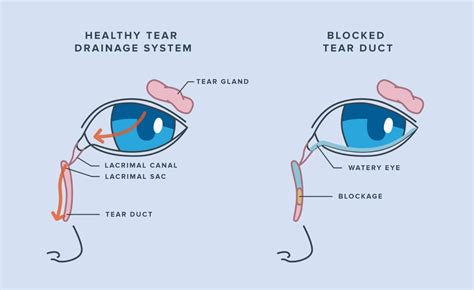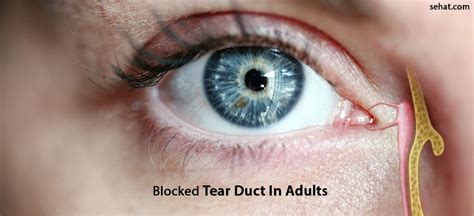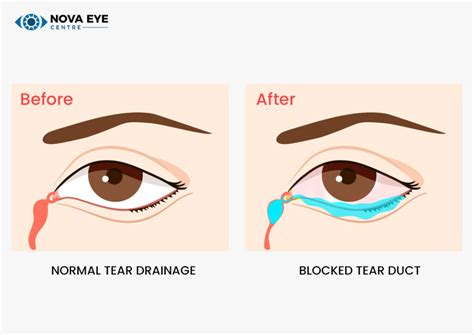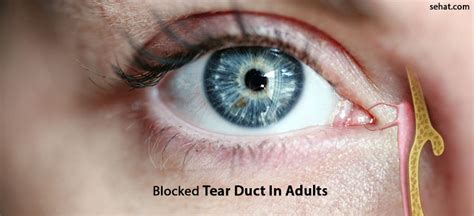Intro
Learn about blocked tear duct symptoms, causes, and treatments, including nasolacrimal duct obstruction, tear duct surgery, and lacrimal sac infection, to remedy excessive tearing and eye discharge.
A blocked tear duct is a common condition that affects people of all ages, causing discomfort, pain, and vision problems. The tear ducts play a crucial role in draining tears from the eyes into the nasal cavity, and any blockage can lead to a range of symptoms. In this article, we will delve into the world of blocked tear ducts, exploring the causes, symptoms, diagnosis, and treatment options available. Whether you're a concerned parent or an individual experiencing symptoms, this comprehensive guide will provide you with the knowledge and insights you need to understand and address this condition.
The importance of tear ducts cannot be overstated. They are responsible for maintaining the health and integrity of the eyes, and any blockage can lead to serious complications. A blocked tear duct can cause excessive tearing, eye discharge, and even vision problems. In severe cases, it can lead to infections, corneal ulcers, and even vision loss. It's essential to recognize the signs and symptoms of a blocked tear duct and seek medical attention promptly to prevent long-term damage.
The symptoms of a blocked tear duct can vary depending on the severity and location of the blockage. Common symptoms include excessive tearing, eye discharge, redness, and swelling. In some cases, people may experience pain or tenderness in the affected eye, and vision problems such as blurred vision or double vision. If left untreated, a blocked tear duct can lead to chronic eye infections, scarring, and even vision loss. It's crucial to seek medical attention if you or your child is experiencing any of these symptoms to prevent long-term damage and ensure proper treatment.
Causes of Blocked Tear Ducts

Types of Blocked Tear Ducts
There are several types of blocked tear ducts, each with distinct causes and symptoms. Congenital blocked tear ducts are present at birth and are usually caused by underdeveloped or narrow tear ducts. Acquired blocked tear ducts, on the other hand, develop later in life due to injuries, infections, or other factors. Partially blocked tear ducts may cause intermittent symptoms, while completely blocked tear ducts can lead to chronic eye problems.Symptoms of Blocked Tear Ducts

Diagnosis of Blocked Tear Ducts
Diagnosing a blocked tear duct typically involves a combination of physical examination, medical history, and diagnostic tests. A doctor may use a slit lamp to examine the eyes and tear ducts, and may also use a dye test to visualize the tear ducts. Imaging tests such as CT or MRI scans may be used to rule out other conditions and confirm the diagnosis.Treatment Options for Blocked Tear Ducts

Prevention and Management
Preventing and managing a blocked tear duct requires a combination of good hygiene, regular eye exams, and prompt medical attention if symptoms occur. People can reduce their risk of developing a blocked tear duct by: * Practicing good hygiene and keeping the eyes and face clean * Avoiding rubbing or touching the eyes * Wearing protective eyewear during sports or other activities * Getting regular eye exams to detect any potential problems early onComplications of Blocked Tear Ducts

Coping with Blocked Tear Ducts
Coping with a blocked tear duct can be challenging, but there are several strategies that can help. People can: * Practice relaxation techniques such as deep breathing or meditation to manage stress and anxiety * Keep a journal or log to track symptoms and progress * Connect with others who have experienced similar conditions * Seek support from family, friends, or a therapistConclusion and Next Steps

What are the common symptoms of a blocked tear duct?
+Common symptoms of a blocked tear duct include excessive tearing, eye discharge, redness, and swelling. In some cases, people may experience pain or tenderness in the affected eye, and vision problems such as blurred vision or double vision.
How is a blocked tear duct diagnosed?
+Diagnosing a blocked tear duct typically involves a combination of physical examination, medical history, and diagnostic tests. A doctor may use a slit lamp to examine the eyes and tear ducts, and may also use a dye test to visualize the tear ducts.
What are the treatment options for a blocked tear duct?
+Treatment for a blocked tear duct depends on the underlying cause and severity of the condition. In some cases, treatment may involve watchful waiting, as the blockage may resolve on its own. Other treatment options include antibiotic ointment or drops, massage therapy, probing and irrigation, and surgery.
We hope this comprehensive guide has provided you with a deeper understanding of blocked tear ducts and the importance of seeking medical attention if symptoms occur. If you have any questions or concerns, don't hesitate to reach out to a healthcare professional for guidance and support. Share this article with others to help raise awareness about the importance of eye health and the need for prompt medical attention if symptoms of a blocked tear duct occur.
